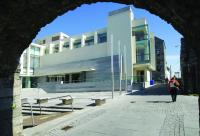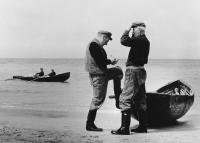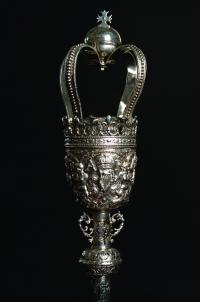Galway City Museum Spanish Arch, Galway
Published in 20th-century / Contemporary History, Issue 2(March/April 2011), Reviews, Volume 19
Galway City Museum—housed in a brand-new, purpose-built, two-storey edifice, which, although out of keeping with the Spanish Arch in the foreground, is historical in being a monument to that extinct creature the Celtic Tiger. (Galway City Museum)
When I last visited Galway City’s museum it was in an ancient single-storey building beside the Spanish Arch. It was run by an amateur committee and, like most such museums, had a dusty, dark atmosphere with lots of objects out on display, some in cases, many not. The information was typed on slips of cardboard and not always easy to read. The present city council-run museum is a million miles away from this. It is housed in a brand-new, purpose-built, two-storey edifice, which, although out of keeping with the Spanish Arch and other remnants of old Galway nearby, is historical, I suppose, in being a monument to that extinct creature the Celtic Tiger.
Like most modern museums, it has an attractive café and is light and airy. Visitors need not fear bumping into a display case or any of the artefacts, as there is plenty of room between them. The museum opens with the gift shop and a currach in the reception area. There are three floors, and most of the museum’s permanent collection is on the ground floor. Here, as elsewhere, the exhibits are divided into sections with headings like ‘Law and Order’, ‘Gaillimh Fadó’, ‘Everyday Life’, ‘From Pirates to Prioresses’, and so on. Pride of place is given to the statue of Pádraic Ó Conaire, a Galway native and Irish writer, which is presumably safe here from the vandals of Eyre Square. Nearby is a photo and video exhibit about President John F. Kennedy’s visit to the city in 1963.
The rest of the ground floor is taken up with the bulk of the museum’s permanent collection, devoted to trade and industry along with everyday life. In the display cabinets here are clay pipes and moulds, bottles, jugs and other items that recall Galway’s history as a commercial and trading centre. Worth looking out for are a charming child’s tricycle and a Portuguese faience vase, a reminder of the city’s trading links in times past. Around this area too are information panels that use words and photographs to shed light on the history of particular areas, such as the Claddagh, or on aspects of the city’s past, like its old theatres.

Leading image in the currach exhibition, taken on the Aran Islands.
While looking at all this, you may get the feeling of a large presence looming overhead. Look up and you will see the Máirtín Oliver, an almost full-size replica of one of the famed Galway hookers that used to ply their trade around Ireland’s west coast and beyond. This one is named after a famous ‘king’ of Claddagh. You get a better view of the boat as you ascend the stairs to the first floor.
Given the city’s association with the hooker, you might expect to find the next gallery devoted to it, so it comes as a surprise to see an exhibition on currachs. A variety of these boats are on display, from the small round craft once used on the River Boyne to seagoing vessels from Kerry and the islands off Ireland. It is not often that you get a chance to examine these up close to appreciate the skill and artistry that goes into their making as well as the subtle differences between them, as each was adapted to the conditions where it was used, such as Tory Island off Donegal or the Aran Islands in Galway Bay.
The museum makes good use of its space to house temporary collections. While I was there these included modern paintings of the Scottish knights at the Battle of Bannockburn, a tribute to the film work of Bob Quinn in Connemara, and photographs taken by Bill Doyle of currachs and fishermen in the recent past. Among all this I also found a display case with a nineteenth-century waistcoat and skirt from the Aran Islands similar to those seen in the photographs. It must also be said that the airy windows on this floor provide panoramic views of the city and Galway Bay.
More remnants of the past are found in a collection of eighteenth-century ecclesiastical silver. This is on loan from the Dominican Sisters and includes pieces by Richard Joyce, the celebrated silversmith credited with inventing the Claddagh ring. The brief descriptions of each item, such as the candlesticks and altar cruets, left me wanting to know more about the story behind each item and its significance. This was particularly true of a silver and glass reliquary case, which appeared to contain part of a human skull, possibly of St Ursula.

Galway City’s ceremonial mace. (Galway City Museum)
The top floor of the museum is occupied by a collection of photographs of people, places and events of Galway and the surrounding area from decades past. This leads to the next major permanent exhibition, which is devoted to Galway and the wars of empire. This concentrates on regiments from Galway, such as the 88th Foot and the famous Connaught Rangers, which fought in Britain’s wars in the Crimea, against the Zulus and the Boers, and in the First World War. On display are rifles, revolvers, uniforms, drums and so on reflecting this military tradition. There is also information on the 1916 Rising and the execution of Pte James Daly for his part in the Connaught Rangers’ mutiny in 1920. The most eye-catching part of the exhibition, however, is the First World War posters, which utilised traditional symbols of Ireland and images of ‘the fighting Irish’ to boost recruitment into the British army.
And there the museum ends, leaving the visitor to take the lift back to the ground floor. This museum is impressive in some ways; it is not just its building which is modern but also its approach to how a museum should function and what its purpose is. The traditional layout of exhibitions, following a chronological order through the different historical periods with an underlying narrative, is replaced with a more thematic arrangement that gives the visitor an impression of Galway’s history rather than a full picture. The exhibitions begin with the ground-floor gallery on commerce and trade and end with the one on military history. In between is an eclectic mix of permanent and temporary displays that draw the visitors’ attention to aspects of the city’s history without reference to a time-line. If the intention is to make a visit to the museum a pleasant way to pass the time rather than a ‘history lesson’, then it has succeeded. HI
















